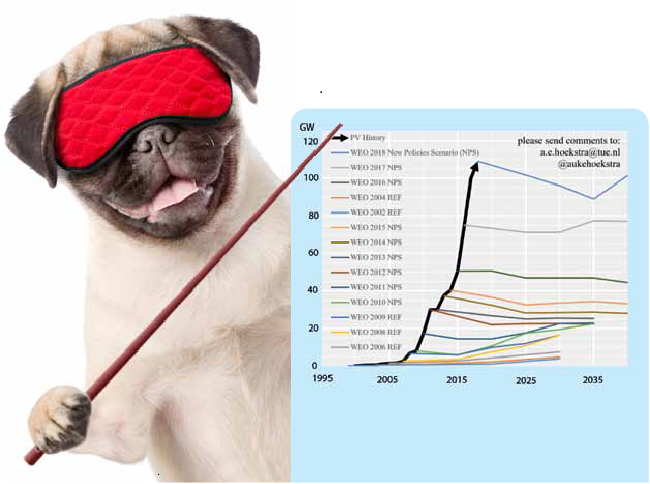The World Energy Outlook (WEO) from the International Energy Agency (IEA), the self-acclaimed “gold standard of long-term energy analysis”, is increasingly being questioned for pointing in the wrong direction.
The New Policies Scenario (NPS) is the IEA’s main scenario, renamed for 2019 as the Stated Policies Scenario, in which it claims to incorporate announced policy and targets and to “hold up a mirror to the plans of today’s policy makers and illustrate their consequences, not to guess how these policy preferences may change in the future”.
The IEA also produces two other sets of projections: the Current Policies Scenario and the Sustainable Development Scenario (SDS). The SDS claims to be Paris-compatible.
Oil Change International (OIC), a US NGO think-tank with links to the Sierra Club, has questioned both the “mirror” line of argument and whether the SDS is what it claims to be.
The Stated Policies Scenario projects large investments in fossil fuels, and that more oil, gas and coal will be used by 2040 than in 2017. (This can be seen from the tables at the end of the 810-page report, but it costs EUR 120.)
Oil Change International has demonstrated that both the Stated Policies Scenario and SDS are used as justification for a fossil future.
“The Canadian Association of Petroleum Producers routinely uses the WEO to justify the expansion of the tar sands. In its 2018 Financial and Operating Review, ExxonMobil cites the WEO as showing that USD 21 trillion in cumulative investment in oil and gas is needed from 2018 to 2040. Last year, Norway’s energy minister cited the SDS to justify Norway’s continued expansion of oil production, saying Norway will “be there as a stable producer of oil and gas for decades to come”. In the New York Times, BP CEO Bob Dudley also cited the SDS as a reason why the world needs more oil and gas.
The SDS is not a 1.5 °C scenario; it has a 50 per cent chance of staying below 1.65 °C. This looks close, but it is achieved with a massive overshoot, with massive nuclear and massive CCS. The overshoot means that it will deliver not by 2050, but by 2070, which is a time horizon that does not worry the fossil industry overmuch, as seen in the quotes above.
Oil Change International is not alone. The claim that the SDS is not Paris-compatible has been backed up by Joeri Rogelj, the lead author of the IPCC 1.5 °C report and by Cristina Figueres, the chief negotiator in Paris in 2015.
Another perennial criticism of the WEOs is that they are demonstrably wrong. They always overestimate nuclear and always underestimate solar and wind.
A total of 51 nuclear reactors disappeared from the forecast for 2025 between WEO 2018 and WEO 2019, reducing nuclear output from 3,089 to 2,801 TWh1. WEO 2014 said 3,540 TWh.
In the space of five years, 132 reactors of the future have evaporated.
This has been the pattern since the IEA was formed by the OECD in 1974 as a counterweight to OPEC, the cartel of oil producers, in the wake of the first oil price shock.
As for photovoltaics, Auke Hoekstra, senior adviser on electric mobility at the Eindhoven University of Technology, has published a telling diagram (figure).
 Figure: Annual solar PV ad-ditions: historic data ver-sus IEAWEO predictions. In GW of added capacity per year – source Internation-al Energy Agency - World Energy Outlook.
Figure: Annual solar PV ad-ditions: historic data ver-sus IEAWEO predictions. In GW of added capacity per year – source Internation-al Energy Agency - World Energy Outlook.
The black line to the left shows how many gigawatts of solar was installed each year. The other lines show the IEA forecasts of different years. It looks much like a standing comb. Every year they believe that PV will grow by roughly a constant number in the future, not exponentially. The 2019 forecast, not included in the diagram, is adjusted upwards, but still remains horizontal, meaning that the same amount of capacity is added in all future years. But PV growth has actually been exponential so far, as can be seen from the thick black line. There are no signs of this letting up in the near future.
The reason why the WEO does not explore a true 1.5 degrees scenario by 2050 is simple. It would disturb the present order of energy companies too much:
“The changes required to set such a course are rapid, deep and unprecedented and their implications would be far-reaching and extend well beyond the energy sector.”
The tacit assumption is that the same thing could not be said about climate change itself.
The WEO is however a major analytical undertaking, and produces some unexpected results. Anti-coal organisation sandbag.org.uk was eager to point out that the WEO shows that coal methane emissions are equivalent to the combined CO2 from both aviation and shipping.
As for bio-CCS, WEO is very cautious, and SDS foresees only 0.25 gigatons of it, compared to 4.7 gigatons in the IPCC 1.5 °C median pathway. “Many of the technologies or methods involved are unproven at scale, and could have negative consequences outside the energy system,” they write.
Fredrik Lundberg
1 In 2018, on average the world's 451 reactors produced 5.6 TWh each.


































